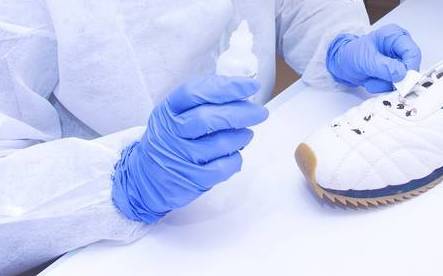READ: Laboratory Safety
Personal Safety Equipment
Eyewear
When working in a lab, it is usually necessary to wear protective eyewear. Eyewear can consist of goggles or safety glasses. Regular eyeglasses or contact lenses are not enough to provide protection. Goggles or safety glasses can be worn over regular glasses. Goggles are usually completely sealed so they protect the eyes from splashes or particles in all directions. Goggles usually have small vents that allow for airflow so the goggles don’t become fogged. Safety glasses aren’t sealed around the face, so they are not as protective on the sides, top, or bottom, but they are sufficient for some uses. Some safety glasses are also made to protect the eyes against certain types of light that may be used in different lab procedures. It is good practice to always wear safety glasses or goggles while in the lab, even if you are not working on something that requires them directly. This is because others in the lab may be working with substances that could potentially get in your eyes if an accident occurs.

Lab coats and aprons
Lab coats or aprons are also necessary while working in the lab. Basic white lab coats are typically worn all of the time. These lab coats serve to protect workers from common spills. The lab coats keep the workers’ clothes from becoming contaminated with biological substances and chemicals. Lab aprons or heavier lab coats can be worn if there is a potential for flames, explosions, or strong chemicals. Regular white lab coats do not provide very much protection against strong acid or base chemicals or flames. Lab technicians and scientists should make sure they are wearing the correct lab coat or apron for the job they are doing.
Gloves
Rubber gloves are often worn by lab scientists and technicians. Gloves usually come in small, medium, and large sizes. They are made of latex, or nitrile for those who are allergic to latex. It is important to use the correct size for your hands so that they are protected, but you can still freely move your fingers to complete your work. Regular latex gloves don’t provide protection from all chemicals. Some chemicals can absorb through the gloves. It is important to use thicker rubber gloves approved for used with strong acids and bases if chemical testing requires it.

Clothing
While working in the lab, closed toed shoes with good traction are required. Closed toed shoes will protect your feet from spills and broken glass. Shoes with good traction will help prevent slips and falls. Long pants are also required so that your legs are protected. Long hair should be tied back so that it won’t drag in chemicals or catch fire if flames or bunsen burners are used. It is a good idea to avoid wearing jewelry as well. Rings can rip rubber gloves and bracelets and necklaces can catch on lab equipment.